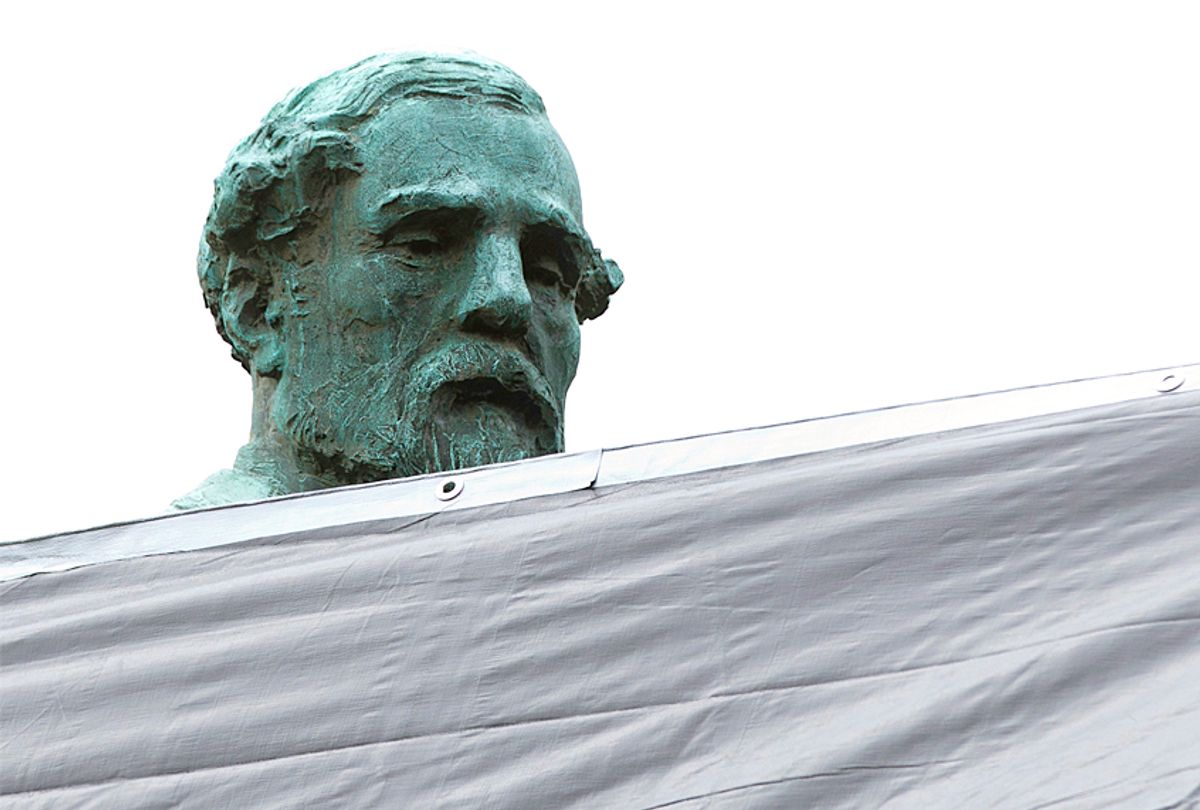On August 11 and 12, 2017, many turned their attention to Charlottesville, Virginia, where white supremacists held large rallies, resulting in horrific scenes of violence, three deaths and dozens of injuries. Many people may not realize that the Confederate statues at the center of the racist violence in Charlottesville remain in place today. Despite the unanimous decision by the local City Council to remove them, city Judge Richard Moore has ruled that Virginia’s “war memorials” law prevents them from doing so. That law permits localities to erect monuments or memorials to any war, including “Confederate or Union monuments or memorials of the War Between the States,” and makes it “unlawful for the authorities of the locality… to disturb or interfere with any monuments or memorials so erected.”
A central question is whether the war memorials law should apply retroactively to cities that put up Confederate statues well before the law applied to them. The “war memorials” law was originally enacted in 1904 as a means to permit the construction and protection only of Confederate statues, and originally applied only to counties in Virginia, not cities. Although various types of war memorials other than Confederate statues were added to the law over the years, it was not until 1997 that the Virginia General Assembly amended the languageto expand its scope to include cities, along with counties. Charlottesville erected its Stonewall Jackson statue in 1921 and its Robert E. Lee statue in 1924, well before Virginia’s war memorials law applied to it in 1997. Prior to Judge Moore’s decision, another city judge in Danville, Virginia, and the Virginia Attorney General both determined the law should not apply retroactively to monuments erected by cities before 1997. Judge Moore disagreed, arguing that “Logic and common sense prevent me” from concluding anything other than that the law should apply retroactively to Charlottesville. Of course, neither Judge Moore’s common sense nor the opinions of the Attorney General or the Danville judge are the final authority here. Only the Virginia Supreme Court can determine how current state law should apply across the state.
It is unlikely the Virginia Supreme Court eagerly awaits an opportunity to rule on how Virginia’s war memorials law should apply to Confederate statues. In addition to whether the law should apply retroactively to cities who erected Confederate statues prior to 1997, such a case raises important constitutional issues. The City of Charlottesville argued to Judge Moore that applying Virginia’s war memorials law to prevent it from removing its Confederate statues violated Equal Protection because “Charlottesville’s depictions of Lee and Jackson are the statuary equivalents of ‘whites only’ signs.” In another case, the city of Norfolk, Virginia, has argued that applying the war memorials law to prevent removal of its “Johnny Reb” statue violates free speech protections because it essentially requires the city to continue displaying a message of white supremacy it no longer supports. Once Judge Moore finalizes his decision, Charlottesville will appeal to the Virginia Supreme Court. But that court would likely prefer that the Virginia General Assembly step in to resolve the issue prior to that point.
The newly blue Virginia General Assembly should take this issue out of the courts and amend the war memorials law to make it clear that cities and counties in Virginia have the right to determine themselves what to do with their Confederate statues. Doing so would resolve the complicated questions of retroactivity and whether cities in Virginia, a Dillon’s Rule state, had the right to erect these Confederate monuments in the first place, when there was no clear law at the time allowing them to do so. It would also solve the constitutional questions of whether localities can be forced by their state to continue displaying racist speech in the form of these statues to the Lost Cause myth of the Confederacy. Such an amendment would also allow localities to make their own decisions about the safety of their communities — allowing places like Charlottesville to decide they no longer want to have these magnets for white supremacist violence at the center of the city.
Most importantly, the General Assembly should amend the war memorials law to allow localities to decide to remove Confederate statues because it is the right thing to do. In too many instances, Virginia has given the wrong answer to questions of racial equality. Virginia was at the center of the development of American slavery and segregation, was the home of the capital of the Confederacy, and on the forefront of the eugenics movement in the United States. Virginia led Massive Resistance against school desegregation and had to be ordered by the Supreme Court to allow interracial marriage in 1967. Virginia is one of three states that host by far the most Confederate statues. The United Daughters of the Confederacy — which paid for so many of these statues — is headquartered in Virginia, and the neo-Confederate group Virginia Flaggers likes to boast about placing dozens of large Confederate flags along Virginia highways.
By amending the war memorials law to clearly allow localities to remove Confederate statues, the General Assembly can take an important step toward rectifying this shameful narrative. The time has come in Virginia to tell the full story of our past and present, and to stop tying the state’s identity to the white supremacist myth of the Lost Cause. Localities must be allowed to define their landscape in a way that is inclusive and protective of all of their residents and to remove the Confederate statues that defeat attempts to portray ourselves as inclusive. Courts are unlikely to take the lead on helping Virginia to redefine itself in this way, and so it is time for the legislature to do so.



Shares